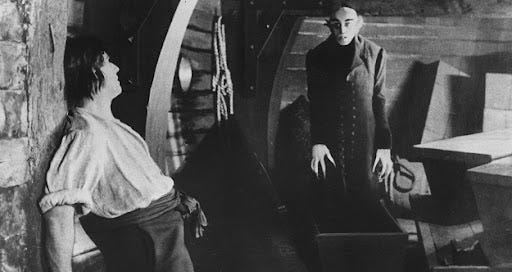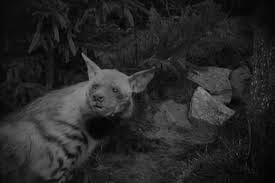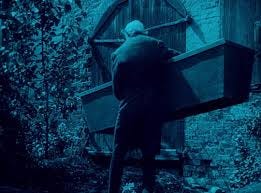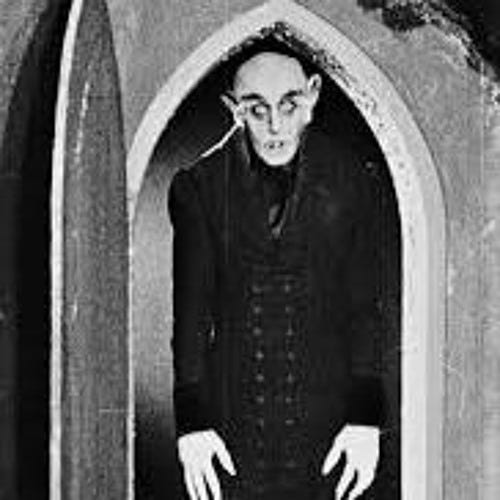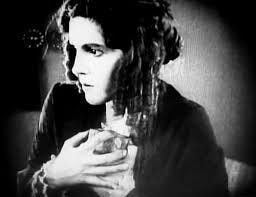It is important, I think, when considering the merits of silent films, to bear in mind always that they ARE silent films - quite a different artform from the films of today, and made in a context so far from the modern one, with technology, conventions and cinematic grammar so distant from the 21st century’s, that to look on them without making adjustments to your own lens would be quite unfair. To be honest this is true, to varying degrees, even of sound films from different eras: if you’re not used to watching 1940s film noir, or Marx Brother comedies, or even 1950s MGM musicals, they’re going to seem weird to you, and if you want to give them a chance, you have to accept them for what they are. But with silent films the gap between the old and the new is even more vast, and you need to make the effort to understand what you’re watching on its own terms. If you go to the opera and bitch about the lack of electric guitar solos, you may have missed the point. And thus with films.
So to Nosferatu: A Symphony of Horror, or in the original German, Nosferatu: Eine Symphonie des Grauens. Directed by FW Murnau for the extremely minor German studio Prana Film, which was co-founded by an occultist the year before the movie came out, and declared bankruptcy shortly after its release. The idea to make a Dracula movie came from said occultist, Albin Grau, who reckoned a farmer once told him his dad was a vampire. The farmer’s dad, that is. I think. Anyway Grau thought making a Dracula film was a nifty idea, and that it would be even niftier if they made it without getting the rights to the book, or getting the approval of Bram Stoker’s estate, and with all the names changed so hopefully nobody would notice. Also, it would all be in German so that would help.
Of course it didn’t help, Stoker’s widow sued them, and all the prints were destroyed. Except obviously not, as I just watched it. Although legally speaking Nosferatu was supposed to cease to exist, some copies survived, and it went on existing, like some kind of creature that everyone thought was dead and yet continued to live by unexpected means. I don’t know what you’d call such a creature.
It’s lucky they did, because Nosferatu, though certainly not to these jaded modern eyes a scary movie, is a fascinating one, and a very striking one, and certainly laid down some building blocks which countless other filmmakers have used to make scarier movies since. Murnau did something very special here, and maybe didn’t know it at the time.
Again, it’s a silent movie, and what that means is that some of it looks…well, silly. Look particularly at the early scene when a “werewolf” (uncertain whether this is an independent werewolf or simply the vampire taking on wolf form, as traditionally he has been able to) scares some horses. The horses, in this scene, are played by horses, which seems reasonable. The wolf, however, is not played by a wolf. In fact it’s not even played by a dog. It’s played by a striped hyena.
Why the wolf is played by a striped hyena is a mystery I can’t solve. It is hard to believe that in Germany in 1921, it was easier for a film producer to get his hands on a hyena than on a wolf - or even on a big mean-looking dog. I can only presume that Murnau believed a striped hyena would be a particularly eerie and disturbing sight.
And hey, for western filmgoers in 1922, maybe it was. David Attenborough would only have been in his mid-fifties at this time, and his documentaries wouldn’t have been as widely available as they are now, so it’s likely that not a lot of people who saw Nosferatu would ever have seen a striped hyena before. So it might’ve come across as super freaky.
But this is certainly not the case now. One problem is that the striped hyena isn’t even the scary-looking kind of hyena. The spotted hyena is the nasty one, the one that always looks like it’s ready to rip your head off. The striped hyena is a rather cute, sweet looking little creature, with the face of a shy puppy who wants to be friends but hasn’t yet mustered up the courage to offer its paw for a shake. The 101 Dalmations look scarier.
So, you know, silly.
That’s a minor thing, of course. It’s a quick and inconsequential scene, over much faster than the time it took to read me banging on about it. But it’s a bit funny. Also funny is the scene where Count Orlok (let us get this straight right now: the vampire in this movie is called Count Orlok. Not Nosferatu. OK? Nosferatu is a word that means vampire. It’s what he is, not who he is. Who he is is Count Orlok. Got it?) carries his coffin to his new house in England.
This is a very silly scene, and one of the parts of the movie where the silliness can’t really be blamed on the conventions of the period. Even in the Twenties, a filmmaker should know that watching a big skinny goblin scuttle around the streets carrying a huge box under his arm looks ridiculous. In the book, Dracula hires a company to transport his boxes to his house. Why Count Orlok couldn’t do this is unexplained. In fact, why Murnau felt the need to even show him getting to his house is unexplained. There’s no point to the scene - it’s not like if you just cut to Orlok at home we’d be leaping from our seats screaming, “BUT HOW”.
Presumably Murnau thought the sight of the hideous monster skulking through the dark and shadowy streets of Wisborg would arouse deep dread. This is undermined not only by the fact that the scenes are clearly filmed in bright sunshine, but by the fact it’s hard to skulk with a bloody great coffin wedged under your arm. What he looks like is a cameo from The Plank. It has the air of imminent slapstick.
Overall, that’s a rare misstep in the portrayal of Orlok, because Nosferatu shares one thing in common with 1931’s Frankenstein: it’s all about the monster. Most of the non-vampire-featuring scenes are fairly ordinary, but Orlok is extraordinary. Otherworldly and horrible to behold, the realisation of the vampire is a triumph both of makeup and of casting - Max Schreck was a weird-looking guy, and he’s perfect for the role. Whack on the sharp teeth, the long pointed ears and nose, the bulbous bald dome, all atop the unsettlingly thin, elongated shape of Schreck himself, shoulders hunched in most inhuman pose, and this is a real CREATURE, you know?
Interestingly there is no attempt, ever, for Orlok to present himself as a suave gentleman, or even just an ordinary human. This departs from the book, and from most adaptations. Orlok enters the movie as a creepy freak, and he is a creepy freak throughout. As I said, to modern eyes, this is not a scary movie, but seeing Schreck stare into the camera with that demonic gaze does raise the odd tingle in the spine. It’s an iconic image for a reason.
Different versions of the movie exist, and in the one I watched one of the irritating elements was that the score included an extremely off-putting vocal motif that played whenever the saintly heroine, Ellen (analogue of Mina Harker) was on screen. It causes her appearances to come off like parodies of bad soap operas, though this is also in part due to Ellen being written and played - by Greta Schroeder - as the wettest human lettuce leaf ever to be put on screen. Although she is actually the great engine of the plot, inasmuch as she is the one who finally takes action to destroy the vampire and save the town of Wisborg from its terrible plague, she does this for most of the running time by sitting around looking pale and tragic and occasionally swooning. The thought of her being claimed by Orlok is by no means unappealing to the viewer - in fact, one yearns for her to become a vampire herself, it could only liven her up. In the end, though, Ellen sacrifices herself to kill Orlok, and so you have to give her credit for that.
This sacrifice is made possible because she reads in a book about vampires that is handily given to her husband Thomas Hutter (analogue of Jonathan Harker, played by the splendidly named Gustav von Wangenheim), that the only way to kill a vampire is for a pure maiden to willingly offer herself up to him, and then get him in the sunlight. Which works out swimmingly.
This is another departure from the book, and a very influential one - any version of Dracula in which he is killed or harmed by sunlight derives from Nosferatu. In Stoker’s book the vampire doesn’t possess all of his powers in the daytime, but he is perfectly able to walk around in the sunshine without suffering any injury. In a way I prefer that, as the whole “killed by sunlight” thing does seem to be an easy way out for writers, but credit must be given to Nosferatu for creating a vampire trope that has stood the test of time.
The book is of course departed from in myriad ways. Renfield becomes Knock (Alexander Granach), and is now Hutter’s boss who deliberately sends him to Transylvania in order to assist Orlok’s coming. Van Helsing becomes Professor Bulwer (John Gottowt), who doesn’t really do a lot at all. England in 1892 becomes Wisborg in 1838, a town in Germany that suffers a dreadful plague due to Orlok’s coming (or possibly due to all the rats who come with him). Nosferatu plays fast and loose with Dracula, but to be honest no faster or looser than the vast majority of Dracula adaptations. Importantly, the heightened monstrousness of the title character, which in physical terms goes further than Stoker in depicting him as a beast of decay and horror with no facade of human charm, is nevertheless in keeping with Stoker’s portrayal of a creature of true and irredeemable evil. There is no tragic love story or tortured soul within the heart of the vampire here. And frankly this is so much to the good. Orlok is not Dracula, but he’s a lot more Dracula than most Draculas are.
As an experience, Nosferatu is often a curiosity, but an extremely engaging one. Granach’s performance as Knock is wildly hammy in classic silent style, and terribly entertaining for it. Gustav von Wangenheim, as Hutter, is quite splendid, hurling himself with gusto into the task of being beset by horror and wracked by guilt and driven to near madness by the thought of Orlok unleashed on the world. If you want to see someone driven to near madness, the masters of the silent screen are who you go to, and von Wangenheim is marvellously over the top in his expressions and wild gesticulations.
Dodgy daylight scenes with underarm coffins aside, Murnau does some lovely Expressionist stuff too. Dark shadows and Gothic castle settings, ominous framings of menacing doorways, and most of all, the beautiful foregrounding of Schreck’s unearthly Orlok. He knew he was on a good thing there. Even if the movie does not move you as it did audiences of the 1920s, it will give you a superb insight into the history of film, and where a hell of a lot of the things you’re used to in movies had their beginning.
